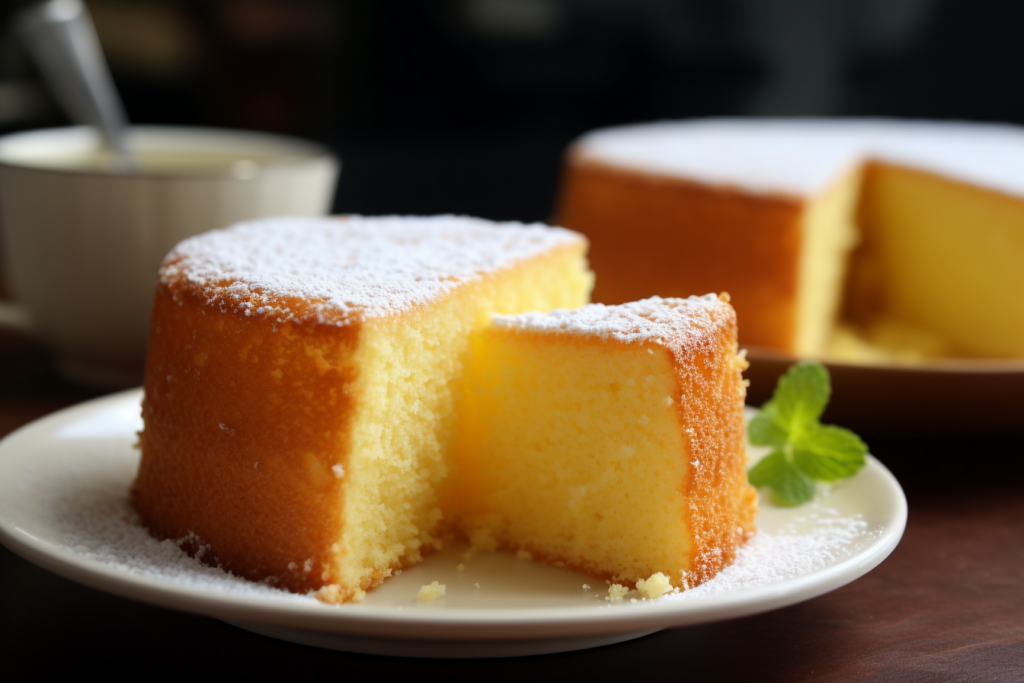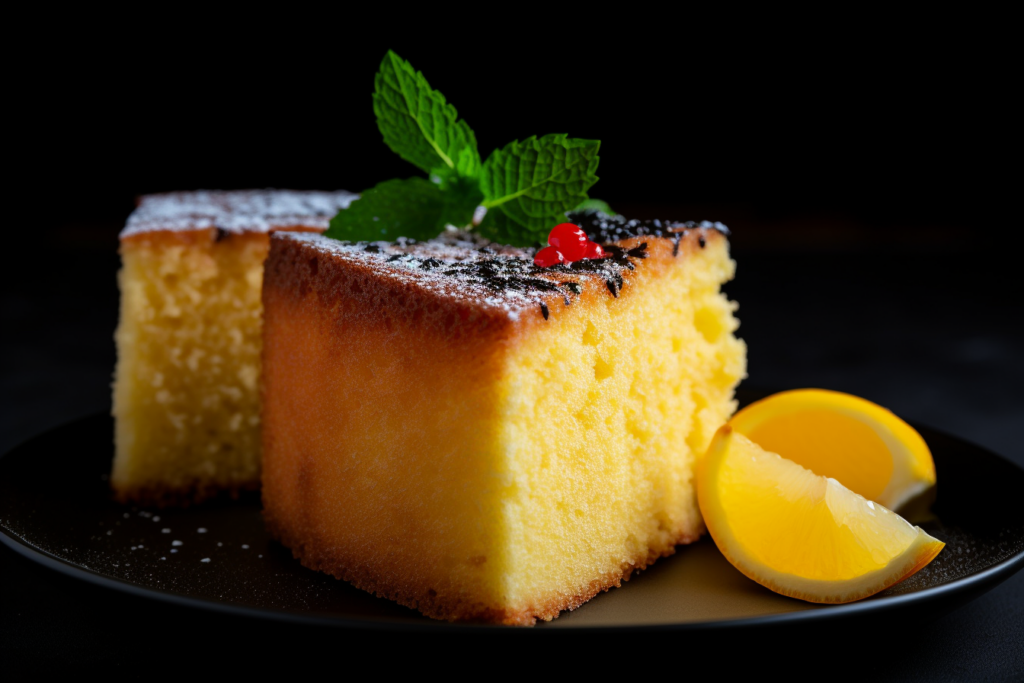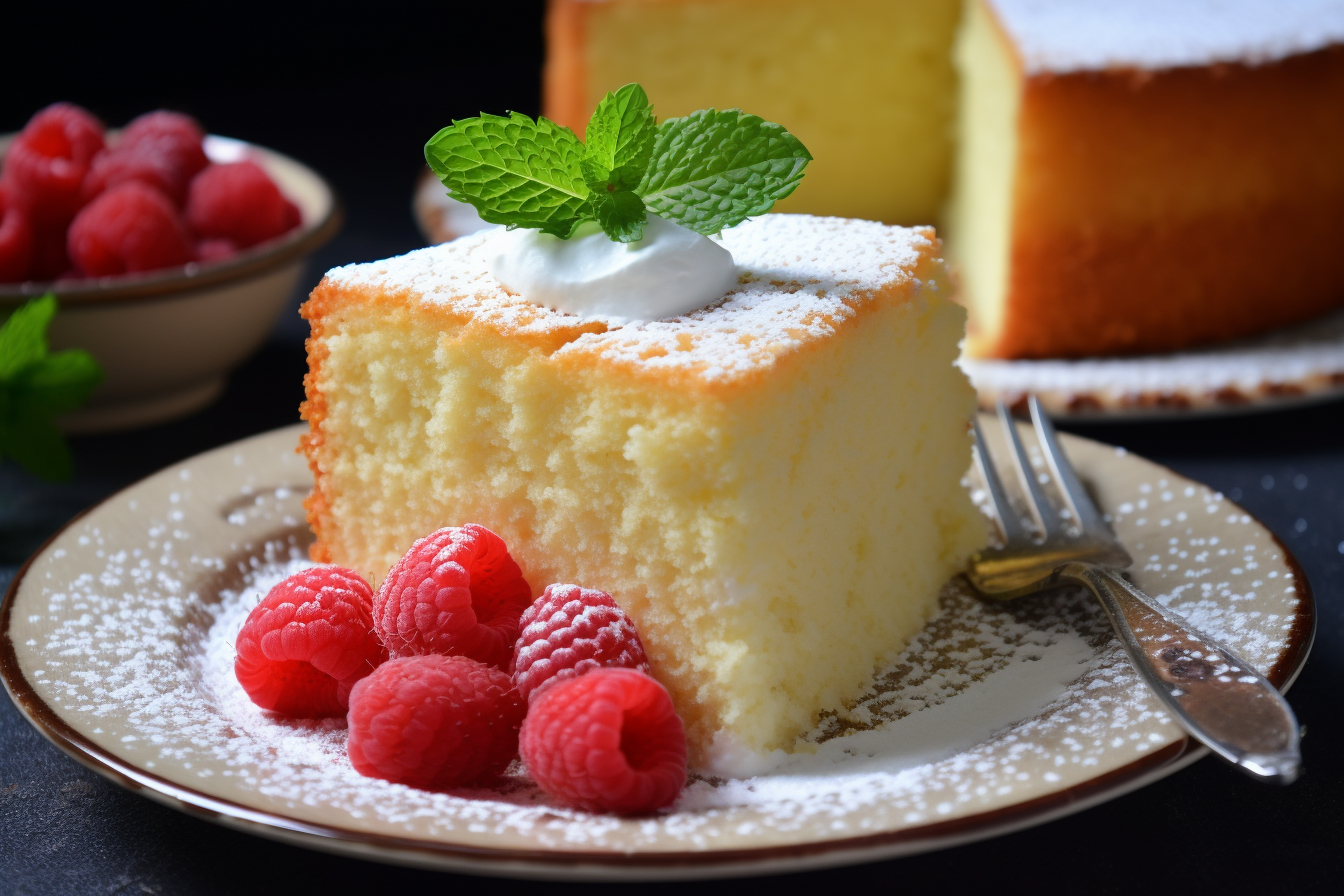Introducing the Sponge Cake, a delightful creation that beckons with its simple yet alluring charm. Picture a golden-brown masterpiece, its surface adorned with a light dusting of powdered sugar, promising a journey into the realm of sweetness. With an inviting aroma that fills the room, this sponge cake is a testament to the magic that unfolds in the oven, as the batter transforms into a light and airy confection.
As your eyes feast upon the delicately risen layers, anticipation builds for the first forkful. The exterior, with its gentle crust, gives way to a soft and moist interior that practically melts in your mouth. The simplicity of its appearance belies the complexity of flavors that emerge with each bite. Whether enjoyed on its own or adorned with a dollop of whipped cream and fresh berries, this sponge cake is a canvas for taste, a celebration of the harmonious marriage of flour, sugar, and eggs.
With every forkful, you embark on a journey of culinary bliss. The sponge cake is more than a dessert; it’s a symphony of textures and tastes that dance on your taste buds. It encapsulates the joy of baking, the sheer pleasure of creating something extraordinary from basic ingredients. Whether shared with friends over tea or savored in solitude with a cup of coffee, this sponge cake is a moment of pure, unadulterated sweetness.
What is Sponge Cake?
Sponge Cake is a light and airy dessert characterized by its spongy texture, achieved through a unique baking process. The key ingredients include flour, sugar, eggs, and sometimes a leavening agent like baking powder. The same ingredients are used in Pound Cake.
What sets sponge cake apart is the method of incorporating air into the batter by whipping eggs until they’re voluminous, creating a foam-like consistency. This aerated mixture gives the cake its distinctive softness and springiness. Sponge cakes can be flavored with vanilla, citrus, or other extracts, adding depth to their delicate taste. Often served plain or with a dusting of powdered sugar, they also provide a versatile base for layered cakes adorned with creams, fruits, or frosting.
Overview: How to make Sponge Cake?

To create a delightful sponge cake, start by preheating your oven to 350°F (175°C) and greasing and flouring two 9-inch round cake pans.
In a large mixing bowl, beat four large eggs until they become thick and pale. Gradually add in 1 cup of granulated sugar, continuing to beat until the mixture is light and fluffy. Sift together 1 cup of all-purpose flour and 1 teaspoon of baking powder, then gently fold this into the egg mixture using a spatula. Be careful not to deflate the batter; the goal is to maintain the airy consistency.
Pour the batter evenly into the prepared pans and smooth the tops. Bake in the preheated oven for about 20-25 minutes or until the cakes spring back when touched lightly. Once baked, let the cakes cool in the pans for 10 minutes before transferring them to a wire rack to cool completely. Serve the sponge cake as is, dusted with powdered sugar, or get creative with your favorite toppings and fillings.
This classic sponge cake, much like the pristine White Cake, is a canvas for endless variations, allowing you to indulge in a light, fluffy, and utterly satisfying treat.
Sponge Cake V/S Pound Cake
| Feature | Sponge Cake | Pound Cake |
|---|---|---|
| Texture | Light, airy, and spongy | Dense, rich, and moist |
| Leavening Agent | Typically relies on beaten eggs for rise | Leavened with baking powder or baking soda |
| Fat Content | Low fat content | Higher fat content, often from butter |
| Eggs | Uses a significant number of eggs | Uses fewer eggs compared to sponge cake |
| Flour | Uses cake flour for a tender texture | Typically uses all-purpose flour |
| Sugar | Moderate sugar content | Higher sugar content for sweetness |
| Flavor | Versatile, often flavored with extracts | Rich buttery flavor, sometimes with vanilla |
| Versatility | Excellent base for layered cakes and desserts | Suitable for various shapes and sizes, good for slicing |
| Toppings/Fillings | Paired well with fruits, creams, and frostings | Often served plain or with a light glaze, fruits, or nuts |
| Origin/History | Ancient origins, evolved over centuries | Originated in Europe, popularized in America |
| Popular Variations | Victoria Sponge, Genoise | Classic Pound Cake, Lemon Pound Cake |
Easy Sponge Cake Recipe
Equipment
- Mixing Bowls
- Measuring Spoons and Cups
- Whisk or Electric Hand Mixer
- Sieve
- 9-inch Round Cake Pans
- Oven and Oven Mitts
- Parchment Paper
- Cooling Rack
- Toothpicks
- Offset Spatula optional
Ingredients
- 4 large eggs
- 1 cup granulated sugar
- 1 cup all-purpose flour
- 1 teaspoon baking powder
- 1 teaspoon vanilla extract optional
- Pinch of salt
Instructions
- Preheat your oven to 350°F (175°C).
- Grease and flour two 9-inch round cake pans.
- In a large mixing bowl, beat the eggs until they become thick and pale.
- Gradually add the sugar to the beaten eggs while continuing to beat. Beat until the mixture is light and fluffy.
- In a separate bowl, sift together the flour, baking powder, and salt.
- Gently fold the sifted dry ingredients into the egg mixture. Be careful not to deflate the batter.
- If using vanilla extract, gently fold it into the batter.
- Divide the batter evenly between the prepared pans.
- Bake in the preheated oven for 20-25 minutes or until the cakes spring back when touched lightly.
- Allow the cakes to cool in the pans for 10 minutes, then transfer them to a wire rack to cool completely.
- Once cooled, you can serve the sponge cake as is, dust it with powdered sugar, or add your favorite toppings and fillings.
Notes
- Aerate Eggs: Beat eggs until pale for a light sponge cake texture. Avoid overmixing.
- Gentle Folding: Fold dry ingredients gently to preserve airiness, preventing a dense sponge cake.
- Precise Baking: Adhere to recommended time; overbaking leads to dryness in sponge cake perfection.
Nutrition
NUTRITIONAL FACTS (PER SERVING)
| Nutrient | Quantity (per serving) |
|---|---|
| Calories | ~200 calories |
| Total Fat | ~8g |
| – Saturated Fat | ~4g |
| Cholesterol | ~90mg |
| Sodium | ~120mg |
| Total Carbohydrates | ~30g |
| – Dietary Fiber | ~0.5g |
| – Sugars | ~20g |
| Protein | ~4g |
Secrets of getting the Perfect Sponge Cake
- Room Temperature Ingredients:
- Bring eggs and other dairy ingredients to room temperature. This ensures better incorporation and a smoother batter.
- Aerate Eggs Thoroughly:
- Beat eggs until thick and pale. This incorporates air, contributing to the cake’s light and fluffy texture.
- Gentle Folding Technique:
- Use a gentle folding motion when combining dry ingredients. Overmixing can deflate the batter, resulting in a dense cake.
- Precise Measuring:
- Accurate measurement of ingredients is crucial for a balanced texture. Use measuring cups and spoons for precision.
- Sift Dry Ingredients:
- Sift flour and other dry ingredients to prevent lumps and ensure even distribution in the batter.
- Correct Oven Temperature:
- Preheat the oven to the correct temperature. Too high or too low temperatures can affect the cake’s rise and texture.
- Avoid Overmixing:
- Once dry ingredients are added, mix only until combined. Overmixing can lead to a tough sponge cake.
- Timely Baking:
- Follow recommended baking times closely. Overbaking can result in a dry sponge cake; underbaking may lead to a collapsed center.
- Cooling Process:
- Allow the cake to cool completely in the pan before removing. This helps maintain its structure.
- Experiment with Flavors:
- Add extracts or zests to enhance flavor. Vanilla, citrus, or almond extracts can complement the sponge cake base.
Remember, practice and adjustments based on your oven and ingredients are key to mastering the perfect sponge cake.
Variations and Substitutions for Sponge Cake
Variations:
- Chocolate Sponge Cake:
- Add cocoa powder to the batter for a rich chocolate flavor.
- Citrus Twist:
- Incorporate lemon or orange zest for a refreshing citrus kick.
- Marble Effect:
- Swirl in chocolate or fruit puree for a marbled appearance and added flavor.
- Lemon Blueberry Sponge:
- Fold in fresh or frozen blueberries and lemon zest for a fruity twist.
- Almond Infusion:
- Include almond extract or ground almonds for a subtle nutty flavor.
Substitutions:
- Eggless Sponge Cake:
- Replace eggs with alternatives like applesauce, yogurt, or vinegar/baking soda mix.
- Gluten-Free Option:
- Use gluten-free flour instead of traditional all-purpose flour.
- Dairy-Free Alternative:
- Substitute dairy milk with plant-based alternatives like almond, soy, or coconut milk.
- Reduced Sugar Version:
- Cut down on sugar or use natural sweeteners like honey or maple syrup.
- Oil Instead of Butter:
- Replace butter with a neutral oil for a lighter texture.
- Whole Wheat Sponge Cake:
- Use whole wheat flour for a heartier and healthier option.
- Flavor Extracts:
- Experiment with different extracts like almond, coconut, or rum for unique flavors.
- Low-Fat Option:
- Substitute some or all of the fat with applesauce or Greek yogurt.
Remember to adjust quantities accordingly and be mindful of the impact on texture and flavor when making variations or substitutions.
PRO TIP: Serve the sponge cake with Raspberry Cake Filling. The tartness complements the sweetness of the cake, enhancing the overall indulgence.
Storing and Handling Leftovers!

To preserve the freshness and texture of leftover sponge cake, follow these storage tips:
- Refrigeration:
- Store the leftover sponge cake in an airtight container or wrap it tightly in plastic wrap.
- If the cake is filled with perishable ingredients like whipped cream or fresh fruit, refrigerate it.
- Avoid Odor Transfer:
- Place the container in the refrigerator away from strong-smelling foods to prevent odors from being absorbed.
- Freezing:
- If you don’t plan to consume the leftovers within a few days, consider freezing the sponge cake.
- Wrap individual slices or the whole cake in plastic wrap and then in aluminum foil to prevent freezer burn.
- Thawing:
- When ready to enjoy, thaw frozen sponge cake in the refrigerator or at room temperature.
- For a quicker thaw, you can use the defrost function on your microwave.
- Refresh with Moisture:
- If the cake becomes slightly dry, consider placing a damp paper towel in the container when refrigerating to help retain moisture.
- Serve at Room Temperature:
- Before serving, allow refrigerated or frozen sponge cake to come to room temperature for the best texture and flavor.
REMEMBER: While storing leftover sponge cake is possible, its quality is optimal when enjoyed fresh. Additionally, toppings and fillings may affect storage recommendations, so adjust based on the specific ingredients used in your cake.
Frequently Asked Questions (FAQs)
Q1: How do you achieve a light texture in a sponge cake?
A: Beating eggs until thick and pale, and gentle folding of dry ingredients help incorporate air, creating a light texture.
Q2: How to store sponge cake?
A: Refrigerate in an airtight container for a few days or freeze wrapped slices for longer storage.
Q3: Can I make a sponge cake without eggs?
A: Yes, you can use egg substitutes like applesauce, yogurt, or vinegar/baking soda mix for an eggless version.
Q4: How do I prevent a sponge cake from becoming dry?
A: Be cautious with baking time, avoid overmixing, and store it properly to retain moisture.
Q5: Can I make a sponge cake with whole wheat flour?
A: Yes, substituting whole wheat flour for a portion or all of the all-purpose flour offers a heartier alternative.

